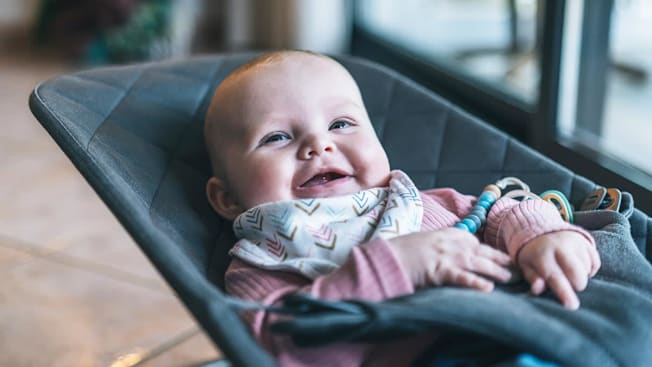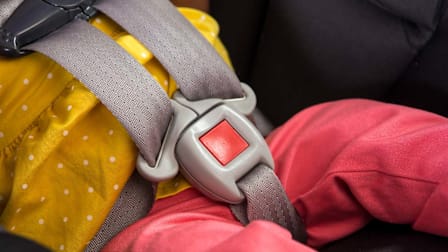Best Baby Bouncers of 2025
The best bouncer seats have a soothing, gentle motion and are easy to clean, set up, and store. We evaluated popular baby bouncers from BabyBjörn, ErgoBaby, Baby Delight, Ingenuity, and Angel Bliss. Here are the ones that impressed our testers the most.
When you shop through retailer links on our site, we may earn affiliate commissions. 100% of the fees we collect are used to support our nonprofit mission. Learn more.

Having a safe place to set down your busy baby while you handle other parenting tasks is a near-constant challenge during the early months. While you could certainly place them in a play yard or crib while you reheat your now-cold coffee or pull on a sweatshirt, a baby bouncer seat can be helpful for this express purpose: It lets baby engage with you and their surroundings from a different vantage point, all while being securely stationed, soothed, and even entertained.
“They are definitely optional, but if I had a newborn, I would buy [a baby bouncer],” says Joan Muratore, the engineer who led CR’s baby bouncer testing. “It’s a short-term-use product, but it provides a safe place for the baby to see the world and explore, kick their legs, and check out that toy bar, while you get a few minutes to do other things.”
How CR Tests Baby Bouncers
CR’s product testing engineers assessed 11 baby bouncers in our lab for overall design, safety, and ease of assembly, cleaning, and storage.
Muratore, who has more than 30 years of experience developing and implementing test programs for baby gear such as strollers, high chairs, and bassinets, led a team of two product testers who assembled and analyzed each baby bouncer over the span of six weeks in CR’s on-site baby gear laboratory. Here’s what they looked for.
- Safety: Using the federal safety standards for baby bouncers as a blueprint, CR’s safety tests check for stability, slip resistance, structural integrity, and warning label placement. “The warning labels are meant to be ‘in your face’ and very visible when placing the baby into the seat, to make sure parents are aware of what not to do,” says Muratore.
- Design: CR’s testing experts look at every aspect of the bouncer’s design, from the fabric and materials used to how well supported or padded the seat is, especially in the foot rest area, where a baby’s kicking feet will need some cushioning. They checked the bouncing motion quality, using a 16-pound cylinder as a “baby”: Was it smooth and soothing or more jerky and irregular? Testers also considered the harness and how easy it is to use or adjust, whether there was an included toy bar, and other features, like sound or vibration.
- Ease of storage: Does the bouncer fold flat for storage? “We give a few points to those that can be disassembled, but that’s still far less convenient than one that folds flat,” says Muratore. “The least convenient for storing are those bouncers that do neither—they can’t fold and can’t even be disassembled.”
- Ease of cleaning: How easy is it to remove and replace the bouncer seat cover? Can the cover be machine-washed or tumble-dried? As parents ourselves, knowing what we know about newborns and diaper blowouts, a bouncer that’s spot-clean only will earn a lower score in this metric.
- Ease of assembly: How many parts and steps are involved in assembly? Is it possible to assemble solo, or do you need another adult’s help? “The highest scores in this metric go to the bouncers that come out of the package already assembled, of course,” says Muratore.
Best Baby Bouncers in CR’s Lab Tests
Other Bouncers We Tested
Looking for more baby bouncer ratings and reviews? More bouncers we tested include:
- Summer Infant 2-in-1 Bouncer & Rocker Duo
- Angelbliss Baby Bouncer
- Ingenuity SmartBounce Automatic Bouncer
- Ingenuity Keep Cozy 3-in-1 Grow with Me Bounce & Rock Seat
- Ingenuity Soothing Baby Bouncer Infant Seat with Vibrations
- Bright Starts Winnie the Pooh Classic Pals Bouncer
- Bright Starts Playful Pinwheels Bouncer
FAQs About Baby Bouncers
Why Do Babies Like to Be Bounced?
Many babies like to be bounced because they find it soothing, as the continuous motion mimics the experience of being in the womb. The movement of a bouncer seat “can stimulate the vestibular system [which helps regulate the nervous system] in a way that helps some babies stay content for a little longer without being held,” says Rachel Coley, OT/L, a pediatric occupational therapist and child development expert with Lovevery. But not all babies like the same types and intensity of movement, Coley says. Some may prefer a side-to-side sway, while others will be soothed by an up-and-down movement.
Are Bouncers Good for Babies?
“The purpose of bouncers is practicality, not infant development,” says Coley, who explains that the primary function of a bouncer is to serve as a safe place for a caregiver to put a baby down for a short period of time when they are awake.
While the bouncing motion can be soothing, and some bouncers have toy bars or arches that a baby can look at or reach for, “none of these functions—soothing, looking, and reaching—are best performed in a bouncer, so it’s helpful to think of them as a means to entertain rather than skill development,” she says.
Can a Baby Sleep in a Bouncer?
No. A baby bouncer is not a safe place for a baby to sleep, given its inclined surface. “While no one wants to disturb a sleeping baby, the baby should be moved to a safe sleep surface such as a crib or bassinet to continue sleeping,” says Nancy Cowles, child product safety expert and former executive director of the child product safety nonprofit Kids in Danger. “Recent research into infant deaths has shown that babies should never sleep in the inclined position, and should never be left unattended in a product with an inclined surface.”
Here are more safe sleep guidelines for infants:
- Always use a crib, bassinet, or portable play yard for sleep with a firm, flat mattress.
- Always place your baby down on their back in their own sleeping space, with no other people or pets.
- Only use a fitted sheet in your baby’s sleeping space.
- Do not put loose blankets, pillows or nursing pillows, stuffed toys, bumpers, baby loungers, or sleep positioners in your baby’s sleeping space.
- Do not use weighted sleep sacks.
- If your baby falls asleep in a car seat, stroller, swing, bouncer seat, or infant carrier, move them to a firm sleep surface on their back as soon as possible.
Are There Safety Risks With Using a Baby Bouncer?
Here are important safety considerations to keep in mind when using a baby bouncer:
- To avoid the risk of a fall, never put your baby in a bouncer seat on an elevated surface like a table, chair, bed, sofa, or countertop.
- Always use the harness straps to keep your baby secure in the seat while they’re bouncing.
- Don’t carry the bouncer seat with your baby in it.
- Don’t leave your baby unattended in the bouncer. “A caregiver should always be close by,” Cowles says.
- Be aware of pets, other children, or potential hazards to your baby while they’re in the bouncer seat. “Watch carefully how pets and older siblings interact with the baby in the bouncer,” Cowles says.
- Bouncer seats are not a safe place for sleeping. If your baby falls asleep, move them to a safe sleep environment, such as a crib, bassinet, or portable play yard, as soon as possible.
How Long Should a Baby Use a Bouncer?
As a pediatric occupational therapist, Coley recommends parents limit the total amount of time their babies spend in their bouncer seat, aiming for an average of less than 2 hours per day. This is because bouncers, car seats, swings, and infant rockers can restrict movement and hold an infant in a semi-reclined position, which isn’t ideal for their overall physical development in the long run. “Babies need plenty of awake time in a variety of body positions with freedom to fully turn their head to each side and extend their arms, legs, and spine,” she says. While there’s no research-backed time limit, Coley suggests aiming to keep a baby in a bouncer for no more than 15 minutes at a time. When it’s time to take your baby out of their bouncer seat, an activity mat or play gym is a safe way to let them explore and play.
As for how long your baby can safely keep using a bouncer seat, that may depend on several factors, such as the bouncer’s weight limit (which tends to be around 20 pounds), and whether your infant is starting to roll over from back to front or is working on sitting up by themselves. In general, most babies stop using a bouncer seat around age 5 to 7 months. If your bouncer seat is convertible, you may be able to transform your bouncer seat into a toddler seat without a harness once your little one is able to fully sit down independently.
Is It Safe to Buy a Used Baby Bouncer?
“Most bouncers, especially those without a power source, are fairly simple, and a gently used product made within the past few years will be safe for use,” says Cowles. If you’re considering a secondhand or hand-me-down bouncer, she recommends first checking for recalls on the product at saferproducts.gov and registering your bouncer—new or used—with the manufacturer to get future recall or safety notices.
How CR Tests Baby Gear
At CR, we hold baby gear to the highest standards—because nothing matters more than your child’s safety. Our testing is rigorous, independent, and free from outside influence. We buy everything we test, and we don’t accept advertising. Our nonprofit mission is to champion fairness, safety, and transparency, and to help every family make confident, informed decisions about the products they use. Support our efforts by becoming a member or donating to our mission today.




























